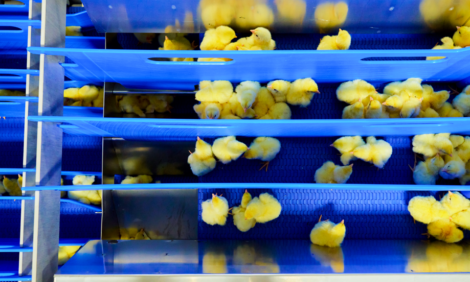



Coccidial Vaccination and Feed Strategy
Feeding strategy should be considered when vaccinating with a live coccidial vaccine, especially under antibiotic free conditions, writes Linnea Newman, DVM.The immune response to live coccidial vaccine requires exposure to multiple life cycles of each of the Eimeria species in the vaccine. The peak of Eimeria reproduction in the digestive tract is generally at 14-21 days of age, depending upon environmental conditions.
Most vaccinated flocks do not need special feeding considerations. However, when using grains other than corn, or when growing antibiotic-free broilers, the feeding strategy should prepare flocks to withstand the response to vaccination, and then should help the birds maximise their performance for greatest economic advantage.
Pre-starter/starter phase
Ideally, the early feeds should be divided into a pre-starter for about 7-8 days of age, followed by a starter feed. Avoid feed changes during the critical peak of Eimeria oocyst output, as changes to the feed form or formulation can disrupt intestinal microflora, resulting in dysbacteriosis or enteritis.
The formulation of the pre-starter is most critical for companies raising birds without antibiotics, but the ideal strategy is the same for all vaccinated flocks.
The focus for early feeds is on digestibility. The pre-starter should consider the use of synthetic amino acids to avoid undigested protein in the hind gut.
Corn-soy rations may have 88 per cent lysine digestibility in chicks over 10 days old, but the digestibility can be as low as 78 per cent in baby chicks (Batal, 2002). Low digestibility means that the extra 22 per cent of lysine goes to the lower intestine and caeca, where it can feed the growth of unfriendly microflora, such as Clostridium perfringens.
Pre-starter cereals should be pre-cooked and extruded; proteins should be animal-based or synthetic amino acids. Fats should come from high quality vegetable sources only.
Diets based upon wheat must use a high-quality enzyme package to improve digestibility. The starter phase may benefit from coarse particle size to encourage the production of butyrate and to develop a more diverse microflora population.
Encapsulated butyrate can also be added to the ration to maximise villus development and repair, in the presence of the mild coccidial challenge produced by vaccination. The addition of betaine during this phase helps to regulate the movement of water across the intestinal cell membranes, preventing coccidiosis-induced dehydration of the villi.
To reduce inflammation and enhance cellular immunity to coccidiosis, the mannan-oligosaccharide (MOS) products as well as vitamin E and selenium have important roles. Growth during this period is not emphasised; protection of intestinal villi and maintenance of intestinal microflora balance are more critical.
Grower/finisher phase
Once immunity has developed, the flock will grow quickly to meet or exceed its genetically programmed weight. Protein and energy to support the desired feed efficiency or breast yield are critical during this phase.
When energy cost is high, coccidial vaccinated birds have a more efficient utilisation of low energy finisher feed (Newman & Teeter, 2012), while still achieving the final target weight.
In-feed anticoccidial flocks often experience a mild coccidiosis challenge at the later stages of growth and may not tolerate low energy or cheaper ingredients.
Coccidial vaccinated flocks are tolerant during this period of growth, so costs of the later feeds can be reduced to compensate for some of the higher-cost ingredients used in the pre-starter or starter phases.










